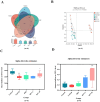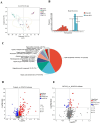Regulation mechanism of Rosa roxburghii Tratt. (Cili) fruit vinegar on non-alcoholic fatty liver disease
- PMID: 40873448
- PMCID: PMC12378049
- DOI: 10.3389/fnut.2025.1617931
Regulation mechanism of Rosa roxburghii Tratt. (Cili) fruit vinegar on non-alcoholic fatty liver disease
Abstract
Background: Non-alcoholic fatty liver disease (NAFLD) is a chronic liver disease characterized by the excessive accumulation of lipids as a pathological feature. Previous studies have demonstrated that Rosa roxburghii Tratt. fruit vinegar (RFV) played an important role in intervening in obesity and related complications by regulating the intestinal microbiota in high-fat diet mice.
Methods: This study investigated the mechanisms by which RFV improves NAFLD from multiple perspectives. Potential targets were predicted by network pharmacology and molecular docking analyses. Intestinal microbial communities were detected and analyzed using 16S rRNA gene sequencing technology. Liver metabolites were detected and analyzed using ultra high performance liquid chromatography quadrupole-exactive high field-X mass spectrometer (UHPLC-Q-Exactive HF-X) and Progenesis QI software. Hepatic protein expression levels were detected and quantified using Western blotting analysis and gray-value analysis, respectively.
Results: The results indicated that, RFV could improve the diversity of intestinal microbiota in NAFLD mice, reduce the ratio of Firmicutes to Bacteroidetes (F/B), and reverse the relative abundance of differential bacteria genera related to lipid accumulation and energy metabolism. The intestinal microbiota was correlated with the levels of lipid metabolism and oxidative stress in the serum and liver of mice with NAFLD. The primary bacteria genera involved were Allobaculum, Faecalibaculum, Dubosiella, Blautia, and unclassified_f_Lachnospiraceae. A total of 441 liver metabolites were identified in NAFLD mice and participating in 21 metabolic pathways. Glycerophospholipid metabolism may be an important pathway regulating NAFLD by RFV. Phosphatidylcholines (PC) and lysophosphatidylcholinergic (LPC) metabolites were significantly regulated by RFV and had significant correlation with differential microbiota. RFV may improve NAFLD by regulating lipid synthesis in the adenosine 5'-monophosphate (AMP)-activated protein kinase (AMPK) pathway. Western blotting analysis showed that, RFV could activate the AMPK phosphorylation, and reduce the expression of fatty acid synthase (FASN) and sterol regulatory element-binding protein 1 (SREBP-1c), resulting in the inhibition of fatty acids de novo synthesis and lipid accumulation.
Conclusion: As a functional food, RFV has been proven to be effective in improving NAFLD. The underlying mechanisms involve the modulation of the intestinal microbiota and metabolites balance, and regulation on lipid disorders through AMPK signaling pathway.
Keywords: AMPK signal pathway; Rosa roxburghii Tratt.; fruit vinegar; intestinal microbiota; metabolomics; non-alcoholic fatty liver disease.
Copyright © 2025 Wang, Lang, Li, Wen, Gao, Zhang, Yang, Li, Wang, Yang, Wang and Xie.
Conflict of interest statement
XW was employed by China National Research Institute of Food & Fermentation Industries Co., Ltd. The remaining authors declare that the research was conducted in the absence of any commercial or financial relationships that could be construed as a potential conflict of interest.
Figures







Similar articles
-
Rhein alleviates hepatic steatosis in NAFLD mice by activating the AMPK/ACC/SREBP1 pathway to enhance lipid metabolism.Mol Med. 2025 Jul 10;31(1):255. doi: 10.1186/s10020-025-01304-4. Mol Med. 2025. PMID: 40640749 Free PMC article.
-
Mechanism of Huanglian Wendan Decoction in ameliorating non-alcoholic fatty liver disease via modulating gut microbiota-mediated metabolic reprogramming and activating the LKB1/AMPK pathway.PLoS One. 2025 Sep 2;20(9):e0331303. doi: 10.1371/journal.pone.0331303. eCollection 2025. PLoS One. 2025. PMID: 40892742 Free PMC article.
-
[Effect of Wenpi Pills on lipid metabolism in mice with non-alcoholic fatty liver disease induced by various diets].Zhongguo Zhong Yao Za Zhi. 2025 May;50(10):2730-2739. doi: 10.19540/j.cnki.cjcmm.20250120.401. Zhongguo Zhong Yao Za Zhi. 2025. PMID: 40686142 Chinese.
-
Statins for non-alcoholic fatty liver disease and non-alcoholic steatohepatitis.Cochrane Database Syst Rev. 2013 Dec 27;2013(12):CD008623. doi: 10.1002/14651858.CD008623.pub2. Cochrane Database Syst Rev. 2013. PMID: 24374462 Free PMC article.
-
The Prevalence of Small Intestinal Bacterial Overgrowth in Patients with Non-Alcoholic Liver Diseases: NAFLD, NASH, Fibrosis, Cirrhosis-A Systematic Review, Meta-Analysis and Meta-Regression.Nutrients. 2022 Dec 9;14(24):5261. doi: 10.3390/nu14245261. Nutrients. 2022. PMID: 36558421 Free PMC article.
References
-
- He JY, Zhang YH, Ma N, Zhang XL, Liu MH, Fu WM. Comparative analysis of multiple ingredients in Rosa roxburghii and R. Sterilis fruits and their antioxidant activities. J Funct Foods. (2016) 27:29–41. doi: 10.1016/j.jff.2016.08.058 - DOI
-
- Chen F, Li L, Peng M, Yan Y, Wang L, Li L, et al. Identification of triterpenoids and hepatoprotective property of Fructus Rosa roxburghii against alcohol-induced liver injury by regulating keap1- Nrf2 signaling. Phytomed Plus. (2021) 1:100102. doi: 10.1016/j.phyplu.2021.100102 - DOI
LinkOut - more resources
Full Text Sources
Research Materials
Miscellaneous

